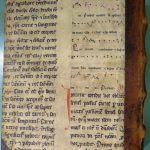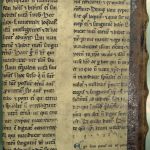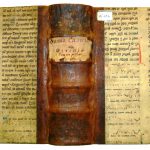These two fragments belong to the second volume of Breviarium notatum Strigoniense (abbr. BNS II), a musically notated breviary of Esztergom from the second half of the 13th century. The codex survived in an entirely fragmented state: most of the corpus (258 fragments) is on the covers of 15th—17th century printed books of the Metropolitanska knjižnica Zagrebačke nadbiskupije (Metropolitan Library, Zagreb), further four fragments are among the detached fragments of the ELTE University Library, Budapest. (For the latter group’s detailed description see fragments F328a and F328b.) At the end of the 17th century – among other manuscripts – the codex was used as raw material by the bookbinder of the Zagreb Chapter after bishop Aleksandar Mikulić (1688—1694) ordered the printed books of the Chapter to be bound uniformly.
Six folios among the fragments of BNS II kept in the Metropolitan Library form a special group. They do not seem to be part of the codex at the first glance: they belong to a 13th-century quire notated with central French musical notation and were most likely attached to the corpus of the notated breviary of Esztergom. This quire of Western origin was inserted into BNS II as a supplement either at the sewing of its quires or it was added later. It may have gotten to Zagreb in the ‘mother codex’, and its leaves became binding material, similarly to the leaves of BNS II. The supplementary quire contains the early, archaic Office of Corpus Christi, the historia Sapientia aedificavit sibi domum. (More to the historia see: Anna Sanda, „»Sapientia aedificavit« – Egy késő középkori ünnep kodifikációjának és zsolozsmaváltozatainak állomásai” [„Sapientia aedificavit“ : Phasen der Entstehung des Offiziums und der Kodifikation eines spätmittelalterlichen Festes], in Gábor Kiss – Gabriella Gilányi ed., Zenetudományi Dolgozatok 2015–2016, HAS Research Centre for the Humanities, Institute for Musicology 2018, 61–85.) Only a few empty staff systems of the quire prove that it was part of the BNS II, as those staves were notated later by one of the two scribes of Esztergom. The applied characteristic musical notation – which completely differs from the central French notation – confirms that the quire of the early Office of Corpus Christi was used in the scriptorium of Esztergom sometime in the second half of the 13th century. If this supplementary quire had not been inserted into the binding of BNS II, it probably may have not been taken to Zagreb and may have not survived until the last decade of the 17th century when the bookbinding project of the Chapter started.
The features of the binding of the incunable kept at the Franciscans of Zagreb under the shelfmark RI-4°-4 prove that the volume originally belonged to the library of the Zagreb Chapter. Its Franciscan author, Astesanus and his work may have awaked the interest of the Franciscan friars, and one of them may have borrowed the book (or may have gotten it as a gift) in the 18th century or in the middle of the 19th century at the latest. In the end, the volume never got back to the collection of the Chapter. Fortunately, it did not get far, since the fragments on its covers have outstanding value: it was bound in the innermost bifolium of the supplementary quire of BNS II, and it contains the formerly missing parts of the Matins of Corpus Christi from the historia Sapientia aedificavit. On the visible sides, the second lesson of the second nocturn (Christus panis est…), its second responsory (Quicumque manducaverit), and its third lesson (Iteratur cotidie…), and the first lesson of the third nocturn (quotation from the Gospel of John and the beginning of St Augustine’s homily Quomodo quidem detur…), and the first responsory (Ego sum panis vitae) are seen in fragmentary form. The bifolium preserved at the Franciscans only shows the central French musical notation, thus its connection with the BNS II can only be verified using the other three bifolia (six fragments) of the Metropolitan Library. The supplementary quire, formerly assumed to be a ternion, proves to be a quaternion with the discussed fragments.
The supplement of BNS II is of incomparable value since it is the earliest known witness of the melodies of the historia Sapientia aedificavit.
Gábriel Szoliva OFM




